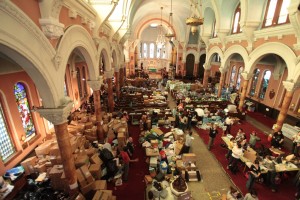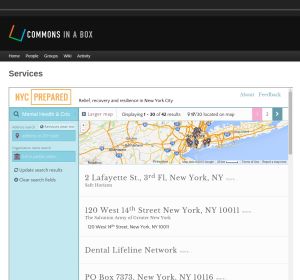In the wake of Superstorm Sandy, many residents of New York City were left struggling.

Though a broad array of supportive services were available to survivors — from home rebuilding funds to mental health treatment — it’s often hard for people to know what’s available and how to access it. New York City lacks any kind of centralized system of information about non-profit health and human services. Given the centrality of non-profit organizations in disaster relief and recovery in the United States, this information scarcity means that for many NYC residents recovery from Sandy never quite happened.
As in any federally-declared emergency scenario, every officially-designated disaster case management program was mandated to use the same information system — the Coordinated Access Network (CAN.org) — to manage survivors’ access to benefits and other steps along the path to recovery. CAN has its own resource directory system, but it is proprietary and not available to the public; survivors often need to make a phone call to a case manager to get even the most basic information about the services. In conversations with those case managers who have had the privilege of being able to access this resource, we’ve heard that its interface is confusing and its data is often duplicated and outdated.
As a result, most disaster case management agencies ended up managing their own resource directories — in isolation from each other. Some organizations were able to cobble together relatively comprehensive service directories, but others don’t have any, and rely on individual case managers to solve the problem themselves. Now, just a bit over two years after the storm, the funding for these disaster case management programs is coming to a close — and so the local, personal knowledge about Sandy recovery services held by these social workers will disappear.
Yet the need remains great. Less than 3% of houses that applied to be rebuilt after Sandy have been completed – and people involved know that this may be a decade-long process for thousands of New Yorkers. The organizations that will serve them will be local, under-funded or entirely unfunded, and organized through a volunteer-based ‘long-term recovery organizations’.
 Our organization, Sarapis, has been providing free/libre/open-source software solutions to grassroots groups and long term recovery coalitions since the storm first hit New York City in October 2012. Through our community technology initiative, NYC:Prepared, we’ve been helping community-based recovery groups make information about critical services accessible to the public. We’ve aggregated what may be the most comprehensive and searchable directory of services for Sandy victims in NYC on the web (a scary thought, considering our organization’s tiny budget).
Our organization, Sarapis, has been providing free/libre/open-source software solutions to grassroots groups and long term recovery coalitions since the storm first hit New York City in October 2012. Through our community technology initiative, NYC:Prepared, we’ve been helping community-based recovery groups make information about critical services accessible to the public. We’ve aggregated what may be the most comprehensive and searchable directory of services for Sandy victims in NYC on the web (a scary thought, considering our organization’s tiny budget).

The data in our directory comes from a hodgepodge of sources: nonprofit websites, PDF printout, shared spreadsheets created by long term recovery group members, and .CSVs produced by individual case managers passionate about sharing resources. Initially, we used Google Spreadsheet and Fusion tables to manage all of this.
With the introduction of the Human Services Data Specification (HSDS), through the Open Referral initiative, we’re now able to manage this information using a standardized, well documented format that others can also use and share. And that’s precisely what we try to encourage others to do.
Openly accessible, standardized human service directory data is critical for each of the phases of a disaster. For disaster preparedness, service information can help identify gaps in the allocation of resources that communities might need during a disaster. For disaster response, many different kinds of organizations and service providers need simultaneous access to the same information. For disaster recovery, survivors need an array of services to get back on their feet, and they should be able to find this information in a variety of ways.
With the Ohana API, we can glimpse a world in which all of the needs above can be met. So we’ve deployed a demonstration implementation of Ohana at http://services.nycprepared.org. In Ohana, we now have a lightweight admin interface for organizing our data and a front-end application to serve it to the public in a beautiful and mobile friendly way. Since Ohana is an API, other developers can use it to make whatever interfaces they please.
 While we’re quite impressed with the Ohana product, its out-of-the-box web search interface won’t meet everyone’s needs. The system that we’d most like to use would be our open source disaster management software called Sahana. Sahana is the world’s leading open source resource management software and we want to build a component — available to any community — that will enable it to consume, produce and deliver HSDS-compatible resource directory data.
While we’re quite impressed with the Ohana product, its out-of-the-box web search interface won’t meet everyone’s needs. The system that we’d most like to use would be our open source disaster management software called Sahana. Sahana is the world’s leading open source resource management software and we want to build a component — available to any community — that will enable it to consume, produce and deliver HSDS-compatible resource directory data.
By making it possible for any agency using Sahana-based systems to consume and publish resource directory data in the Open Referral format, we can shift the entire field of relief and recovery agencies towards more interoperable, sustainable, and reliable practices. Sahana specialists are ready to develop this open source, HSDS-compatible resource directory component — at an estimated cost of $5,000. Please consider donating to our effort. And please reach out to Sarapis if you know of other communities and use cases in which this technology could enhance resilience in the face of crisis.

Leave a Reply